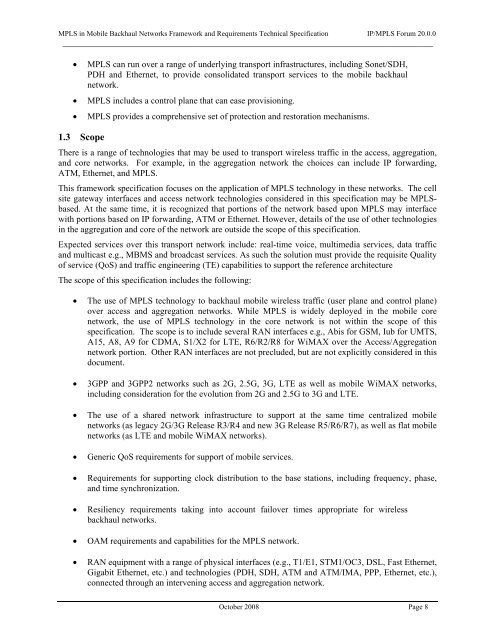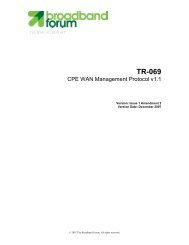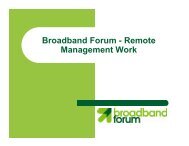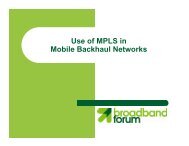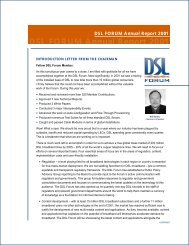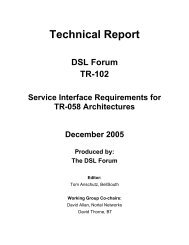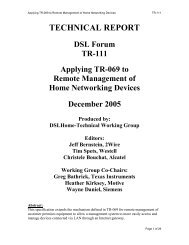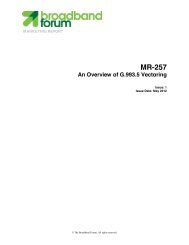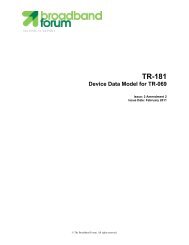MPLS in Mobile Backhaul Networks Framework and Requirements ...
MPLS in Mobile Backhaul Networks Framework and Requirements ...
MPLS in Mobile Backhaul Networks Framework and Requirements ...
Create successful ePaper yourself
Turn your PDF publications into a flip-book with our unique Google optimized e-Paper software.
<strong>MPLS</strong> <strong>in</strong> <strong>Mobile</strong> <strong>Backhaul</strong> <strong>Networks</strong> <strong>Framework</strong> <strong>and</strong> <strong>Requirements</strong> Technical Specification IP/<strong>MPLS</strong> Forum 20.0.0<br />
___________________________________________________________________________________<br />
• <strong>MPLS</strong> can run over a range of underly<strong>in</strong>g transport <strong>in</strong>frastructures, <strong>in</strong>clud<strong>in</strong>g Sonet/SDH,<br />
PDH <strong>and</strong> Ethernet, to provide consolidated transport services to the mobile backhaul<br />
network.<br />
• <strong>MPLS</strong> <strong>in</strong>cludes a control plane that can ease provision<strong>in</strong>g.<br />
• <strong>MPLS</strong> provides a comprehensive set of protection <strong>and</strong> restoration mechanisms.<br />
1.3 Scope<br />
There is a range of technologies that may be used to transport wireless traffic <strong>in</strong> the access, aggregation,<br />
<strong>and</strong> core networks. For example, <strong>in</strong> the aggregation network the choices can <strong>in</strong>clude IP forward<strong>in</strong>g,<br />
ATM, Ethernet, <strong>and</strong> <strong>MPLS</strong>.<br />
This framework specification focuses on the application of <strong>MPLS</strong> technology <strong>in</strong> these networks. The cell<br />
site gateway <strong>in</strong>terfaces <strong>and</strong> access network technologies considered <strong>in</strong> this specification may be <strong>MPLS</strong>based.<br />
At the same time, it is recognized that portions of the network based upon <strong>MPLS</strong> may <strong>in</strong>terface<br />
with portions based on IP forward<strong>in</strong>g, ATM or Ethernet. However, details of the use of other technologies<br />
<strong>in</strong> the aggregation <strong>and</strong> core of the network are outside the scope of this specification.<br />
Expected services over this transport network <strong>in</strong>clude: real-time voice, multimedia services, data traffic<br />
<strong>and</strong> multicast e.g., MBMS <strong>and</strong> broadcast services. As such the solution must provide the requisite Quality<br />
of service (QoS) <strong>and</strong> traffic eng<strong>in</strong>eer<strong>in</strong>g (TE) capabilities to support the reference architecture<br />
The scope of this specification <strong>in</strong>cludes the follow<strong>in</strong>g:<br />
• The use of <strong>MPLS</strong> technology to backhaul mobile wireless traffic (user plane <strong>and</strong> control plane)<br />
over access <strong>and</strong> aggregation networks. While <strong>MPLS</strong> is widely deployed <strong>in</strong> the mobile core<br />
network, the use of <strong>MPLS</strong> technology <strong>in</strong> the core network is not with<strong>in</strong> the scope of this<br />
specification. The scope is to <strong>in</strong>clude several RAN <strong>in</strong>terfaces e.g., Abis for GSM, Iub for UMTS,<br />
A15, A8, A9 for CDMA, S1/X2 for LTE, R6/R2/R8 for WiMAX over the Access/Aggregation<br />
network portion. Other RAN <strong>in</strong>terfaces are not precluded, but are not explicitly considered <strong>in</strong> this<br />
document.<br />
• 3GPP <strong>and</strong> 3GPP2 networks such as 2G, 2.5G, 3G, LTE as well as mobile WiMAX networks,<br />
<strong>in</strong>clud<strong>in</strong>g consideration for the evolution from 2G <strong>and</strong> 2.5G to 3G <strong>and</strong> LTE.<br />
• The use of a shared network <strong>in</strong>frastructure to support at the same time centralized mobile<br />
networks (as legacy 2G/3G Release R3/R4 <strong>and</strong> new 3G Release R5/R6/R7), as well as flat mobile<br />
networks (as LTE <strong>and</strong> mobile WiMAX networks).<br />
• Generic QoS requirements for support of mobile services.<br />
• <strong>Requirements</strong> for support<strong>in</strong>g clock distribution to the base stations, <strong>in</strong>clud<strong>in</strong>g frequency, phase,<br />
<strong>and</strong> time synchronization.<br />
• Resiliency requirements tak<strong>in</strong>g <strong>in</strong>to account failover times appropriate for wireless<br />
backhaul networks.<br />
• OAM requirements <strong>and</strong> capabilities for the <strong>MPLS</strong> network.<br />
• RAN equipment with a range of physical <strong>in</strong>terfaces (e.g., T1/E1, STM1/OC3, DSL, Fast Ethernet,<br />
Gigabit Ethernet, etc.) <strong>and</strong> technologies (PDH, SDH, ATM <strong>and</strong> ATM/IMA, PPP, Ethernet, etc.),<br />
connected through an <strong>in</strong>terven<strong>in</strong>g access <strong>and</strong> aggregation network.<br />
October 2008 Page 8


